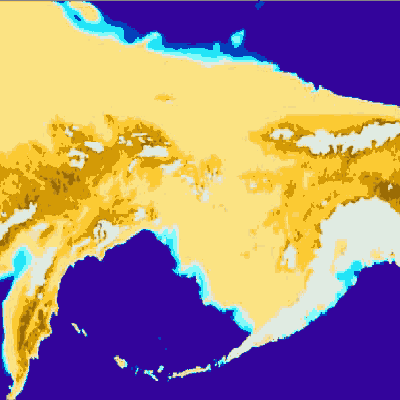 COM.on C.A.3:e8/72-76
Online published on May 17, 2009.
COM.on C.A.3:e8/72-76
Online published on May 17, 2009.doi:10.4236/coca.2009.31008
 COM.on C.A.3:e8/72-76
Online published on May 17, 2009.
COM.on C.A.3:e8/72-76
Online published on May 17, 2009.YANG Jingmin, ZHU Dongchen
MOE Key Laboratory of Contemporary Anthropology, School of Life Sciences, Fudan University, Shanghai 200433 China
Key words: American Indians; Immigration; Last Glacial Maximum; Molecular genetics
Recieved: Apr.16, 2009 Accepted: May. 15,2009 Corresponding: yangjm210@gmail.com
《现代人类学通讯》第三卷e8篇 第72-76页 2009年5月17日网上发行
动态评论
人类征服美洲时间的多角度探讨
杨敬敏, 朱东臣
复旦大学现代人类学教育部重点实验室,上海 200433
摘要:本文综合考古学、地理学、古生态学、分子遗传学等方面的研究成果对人类最早进入美洲的时间进行探讨,并通过对文献中提及的迁移时间进行简单的统计分析。我们认为早期人类在征服美洲时有经历了两次高峰期,一次是在3.55到2.2万年前,另一次是在1.8到1.3万年前。人类在进入西伯利亚后,继续扩张进入当时曾是陆地的白令地区,在白令地区发展壮大并进入美洲大陆;但在2.2到1.8万年前,由于最后一次盛冰期的到来,人类向美洲的迁移受到影响。随着盛冰期的结束,白令地区通向美洲大陆的通道重新打通,大约1.8到1.3万年前,人类再次快速向美洲扩张。
关键词:美洲印第安人;迁徙;盛冰期;分子遗传学
收稿日期:2009年4月16日 修回日期:2009年5月15日 联系人:杨敬敏 yangjm210@gmail.com
1. 陈太荣,刘正勤(1997) 南美洲印第安人起源新说. 拉丁美洲研究 5:54-56.
2. 泰亦赤兀惕·满昌 (2002) 美洲印第安人是蒙古人的分支. 内蒙古民族大学学报(社会科学版) 28 (5):14-21.
3. Elias SA, Short SK, Nelson CH, Birks HH (1996) Life and times of the Bering land bridge. Nature 382:60-63.
4. Pitulko VV, Nikolsky PA, Girya EY, Basilyan AE, Tumskoy VE, Koulakov SA, Astakhov SN, Pavlova EY, Anisimov MA (2004) The Yana RHS site: Humans in the Arctic before the Last Glacial Maximum. Science 303:52-56.
5. Yokoyama Y, Lambeck K, De Deckker P, Johnston P, Fifield LK (2000) Timing of the Last Glacial Maximum from observed sea-level minima. Nature 406:713-716.
6. Schurr TG (2004) The peopling of the New World: Perspectives from molecular anthropology. Ann Rev Anthropol 33:551-583.
7. Bailliet G, Rothhammer F, Carnese FR, Bravi CM, Bianchi NO (1994) Founder Mitochondrial Haplotypes in Amerindian Population. Am J Hum Genet 55:27-33.
8. Bianchi NO, Catanesi CI, Bailliet G, Martinez-Marignac VL, Bravi CM, Vidal-Rioja LB, Herrera RJ, Lopez-Camelo JS (1998) Characterization of ancestral and derived Y-chromosome haplotypes of new world native populations. Am J Hum Genet 63:1862-1871.
9. Bonatto SL, Salzano FM (1997) Diversity and age of the four major mtDNA haplogroups, and their implications for the peopling of the New World. Am J Hum Genet 61:1413-1423.
10. Bonatto SL, Salzano FM (1997) A single and early migration for the peopling of the Americas supported by mitochondrial DNA sequence data. Proc Nat Acad Sci USA 94:1866-1871.
11. Brown MD, Hosseini SH, Torroni A, Bandelt HJ, Allen JC, Schurr TG, Scozzari R, Cruciani F, Wallace DC (1998) mtDNA haplogroup X: An ancient link between Europe western Asia and North America? Am J Hum Genet 63:1852-1861.
12. Forster P, Harding R, Torroni A, Bandelt HJ, (1996) Origin and evolution of Native American mtDNA variation: a reappraisal. Am J Hum Genet 59:935-945.
13. Horai S, Kondo R, Nakagawa-Hattori Y, Hayashi S, Sonoda S, Tajima K (1993) Peopling of the Americas, founded by four major lineages of mitochondrial DNA. Mol Biol Evol 10:23-47.
14. Lorenz JG, Smith DG (1997) Distribution of sequence variation in the mtDNA control region of Native North Americans. Hum Biol 69:749-776.
15. Ruiz-Linares A, Ortiz-Barrientos D, Figueroa M, Mesa N, Munera JG, Bedoya G, Velez ID, Garcia LF, Perez-Lezaun A, Bertranpetit J, Feldman MW, Goldstein DB (1999) Microsatellites provide evidence for Y chromosome diversity among the founders of the New World. Proc Nat Acad Sci USA 96:6312-6317.
16. Santos FR, Pandya A, Tyler-Smith C, Pena SDJ, Schanfield M, Leonard WR, Osipova L, Crawford MH, Mitchell RJ (1999) The central Siberian origin for Native American Y chromosomes. Am J Hum Genet 64:619-628.
17. Seielstad M, Yuldasheva N, Singh N, Underhill P, Oefner P, Shen PD, Wells RS (2003) A novel Y-chromosome variant puts an upper limit on the timing of first entry into the Americas. Am J Hum Genet 73:700-705.
18. Silva WA, Bonatto SL, Holanda AJ, Ribeiro-dos-Santos AK, Paixao BM, Goldman GH, Abe-Sandes K, Rodriguez-Delfin L, Barbosa M, Paco-Larson ML, Petzl-Erler ML, Valente V, Santos SEB, Zago MA (2002) Mitochondrial genome diversity of Native Americans supports a single early entry of founder populations into America. Am J Hum Genet 71:187-192.
19. Shields GF, Schmiechen AM, Frazier BL, Redd A, Voevoda MI, Reed JK, Ward RH (1993) Mtdna Sequences Suggest a Recent Evolutionary Divergence for Beringian and Northern North-American Populations. Am J Hum Genet 53:549-562.
20. Fagundes NJ, Kanitz R, Eckert R, Valls AC, Bogo MR, Salzano FM, Smith DG, Silva WA, Jr., Zago MA, Ribeiro-dos-Santos AK, Santos SE, Petzl-Erler ML, Bonatto SL (2008) Mitochondrial population genomics supports a single pre-Clovis origin with a coastal route for the peopling of the Americas. Am J Hum Genet 82:583-92.
21. Starikovskaya YB, Sukernik RI, Schurr TG, Kogelnik AM, Wallace DC (1998) mtDNA diversity in Chukchi and Siberian Eskimos: Implications for the genetic history of ancient Beringia and the peopling of the New World. Am J Hum Genet 63 :1473-1491.
22. Stone AC, Stoneking M (1998) mtDNA analysis of a prehistoric Oneota population: implications for the peopling of the New World. Am J Hum Genet 62:1153-70.
23. Torroni A, Neel JV, Barrantes R, Schurr TG, Wallace DC (1994) Mitochondrial-DNA Clock for the Amerinds and Its Implications for Timing Their Entry into North-America. Proc Nat Acad Sci USA 91:1158-1162.
24. Torroni A, Sukernik RI, Schurr TG, Starikovskaya YB, Cabell MF, Crawford MH, Comuzzie AG, Wallace DC (1993) MtDNA Variation of Aboriginal Siberians Reveals Distinct Genetic Affinities with Native-Americans. Am J Hum Genet 53:591-608.
25. Elias SA (2001) Beringian paleoecology: Results from the 1997 workshop. Quat Sci Rev 20:7-13.
26. Brubaker LB, Anderson PM, Edwards ME, Lozhkin AV (2005) Beringia as a glacial refugium for boreal trees and shrubs: New perspectives from mapped pollen data. J Biogeogr 32:833-848.
27. Kitchen A, Miyamoto MM, Mulligan CJ (2008) A three-stage colonization model for the peopling of the Americas. PLoS ONE 3(2):e1596.